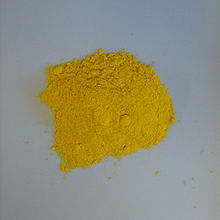Benzimidazolone pigments
Benzimidazolone azo pigments or benzimidazolone pigments for short are azo pigments which are named after the benzimidazolone group contained in the coupling component and which are exceptionally colorfast . Benzimidazolones were developed and manufactured by Hoechst and patented in 1960. They were first used as a pigment in the late 1970s. They are relatively expensive, but they are among the longest lasting organic pigments.
Extraction and presentation
Benzimidazolone pigments, like other azo pigments, are produced by coupling diazotized aromatic amines to a coupling component, the coupling component containing the benzimidazolone group. According to the resulting color , the pigments are divided into yellow series and red series. The use of 5-acetoacetylamino-benzimidazolone creates the yellow series pigments. If 5- (2'-hydroxy-3'-naphthoyl) -aminobenzimidazolone is used, the pigments of the red series are obtained.
Classification
Both series together comprise around 20 azo pigments with a wide range of colors. The commercially most important are CI Pigment Yellow 151 and 154 ( brilliant yellow ) and CI Pigment Orange 36, all pigments of the yellow series. Other most important representatives in the yellow area are CI Pigment Yellow 120, 175, 180, 181 and 194. For the orange pigments there are CI Pigment Orange 37, 60, 62 and 72, and for the red pigments CI Pigment Red 171, 175, 176, 185 and 208. Representatives in the burgundy area are CI Pigment Violet 32 and CI Pigment Brown 25.
The structure of CI Pigment Yellow 151 is representative of the pigments of the yellow series. The basic structure of all azo colorants is easy to see. Benzimidazolone pigments differ, however, in the characteristic 5-aminocarbonylbenzimidazolone grouping in the diazo component (in the graphic on the far right, including the amide group ). The variations in color within the rows result from the different arrangements of the substituents on the aryl radical of the diazo component (shown in the graphic to the left of the azo group).
properties
The pigments of the yellow series have nuances from greenish yellow to orange, those of the red series from yellowish red to Bordeaux. All pigments in this group have in common their extraordinarily good light and weather fastness , which is significantly higher than that of classic azo pigments. The pigments are stable against migration , acids , bases and solvents and are easily dispersible . Most of the pigments in this group also have a high temperature resistance.
use
The benzimidazolones are used technically in emulsion paints and varnishes , high-quality printing inks , plastics and artists' paints . Due to their profile of properties, benzimidazolone pigments are used where there are high requirements, such as in automotive coatings , powder coatings and coil coatings .
literature
- W. Herbst, K. Hunger: Industrial Organic Pigments . 2nd Edition. Wiley-VCH, Weinheim 1997, ISBN 3-527-28744-2 (English).
- Smock: textbook of paints and coatings . 2nd Edition. S. Hirzel, Stuttgart Leipzig, 2003, ISBN 3-7776-1015-1 .
- G. Etzrodt, A. Müller: Plastic coloring . 2nd Edition. Carl Hanser Verlag Munich, 2018, ISBN 978-3-446-45462-0 .
Individual evidence
- ↑ Safe Handling of Color Pigments (PDF file; 212 kB).
- ^ W. Herbst, K. Hunger: Industrial Organic Pigments . 2nd Edition. Wiley-VCH, Weinheim 1997, ISBN 3-527-28744-2 , pp. 353 (English).
- ^ W. Herbst, K. Hunger: Industrial Organic Pigments . 2nd Edition. Wiley-VCH, Weinheim 1997, ISBN 3-527-28744-2 , pp. 357 f . (English).




